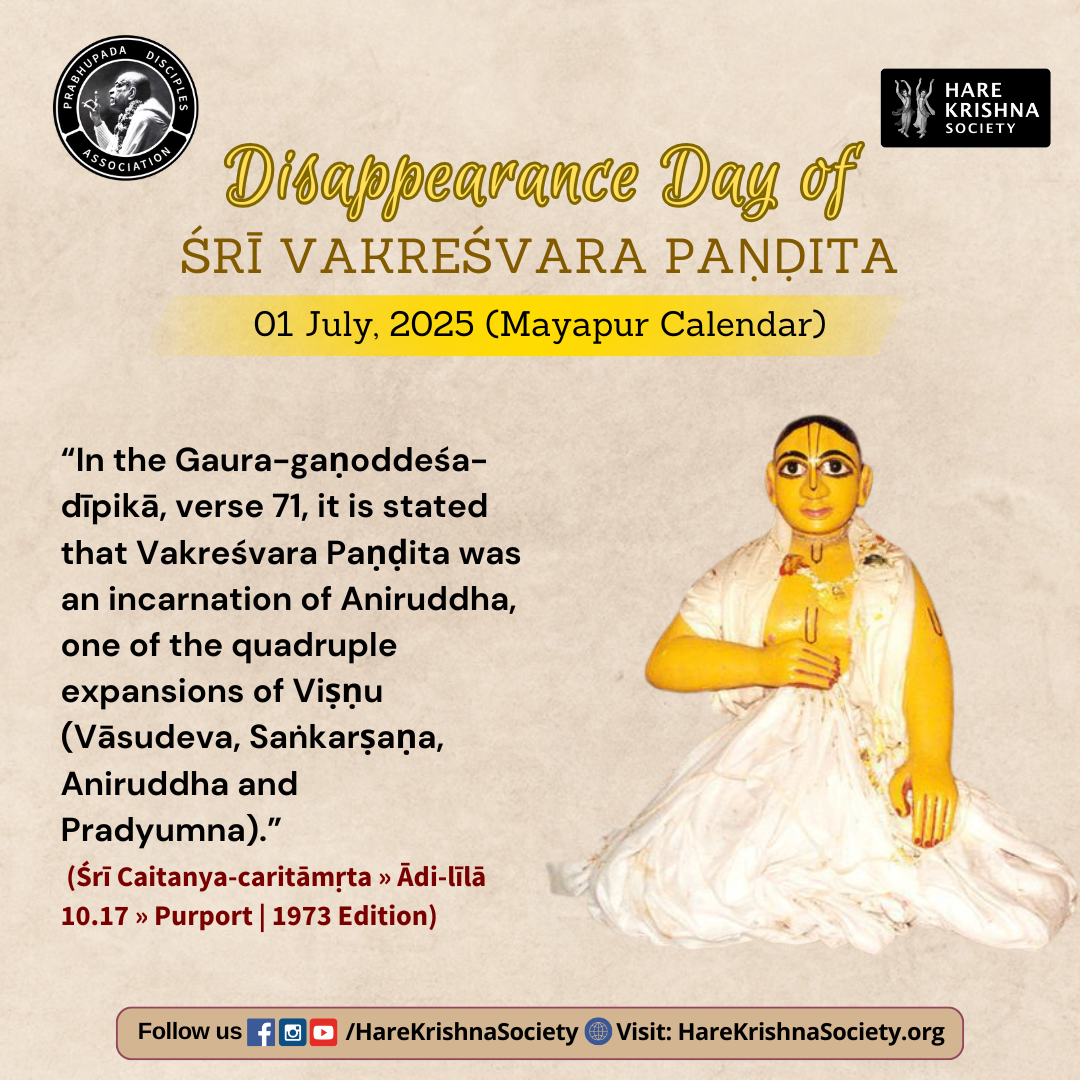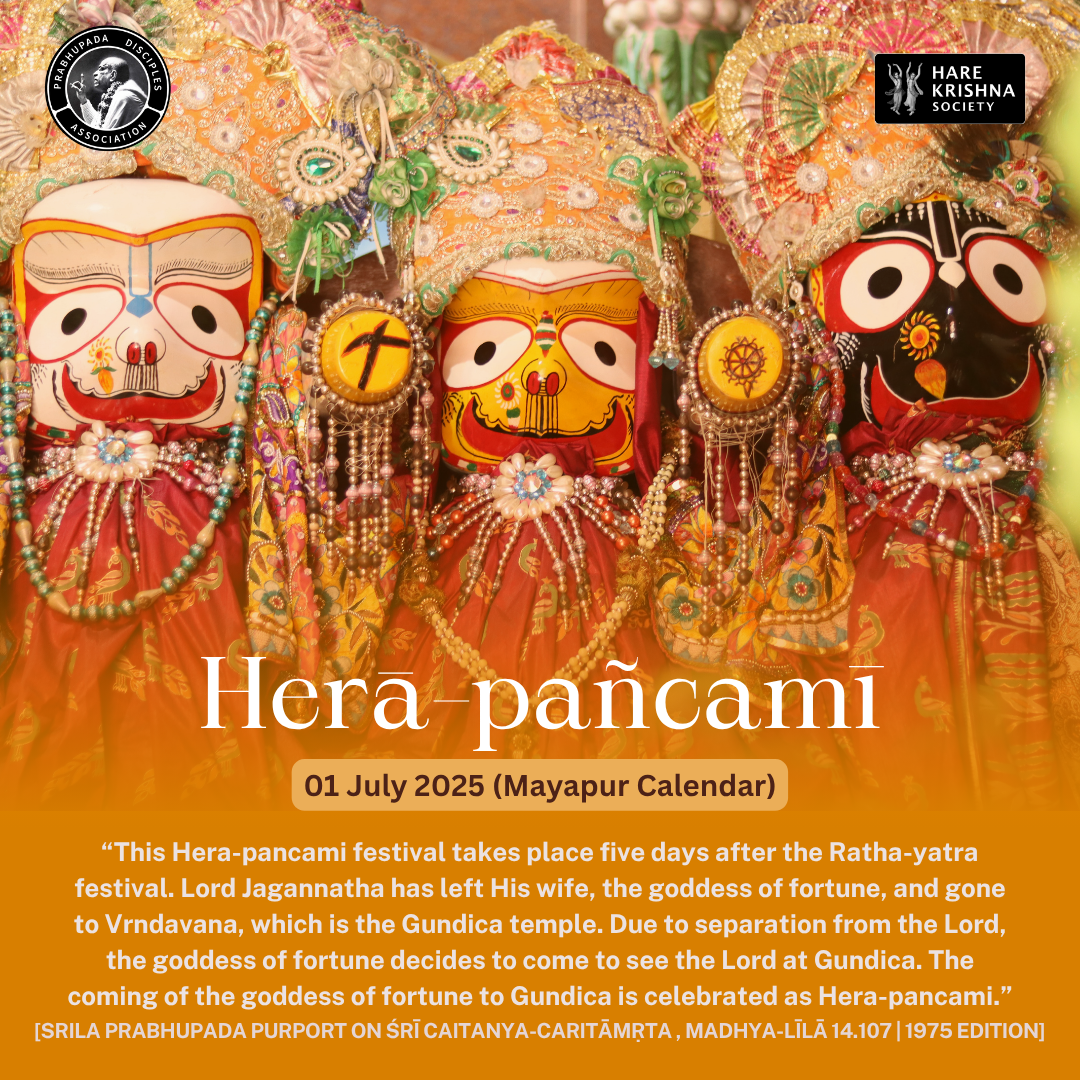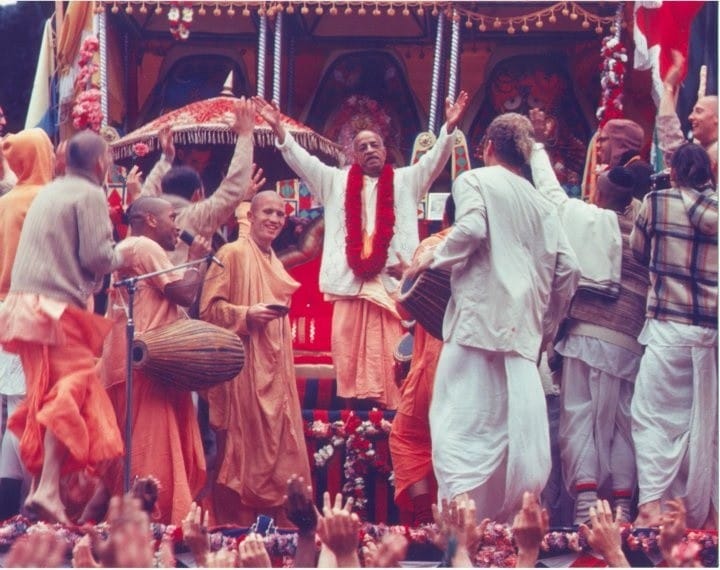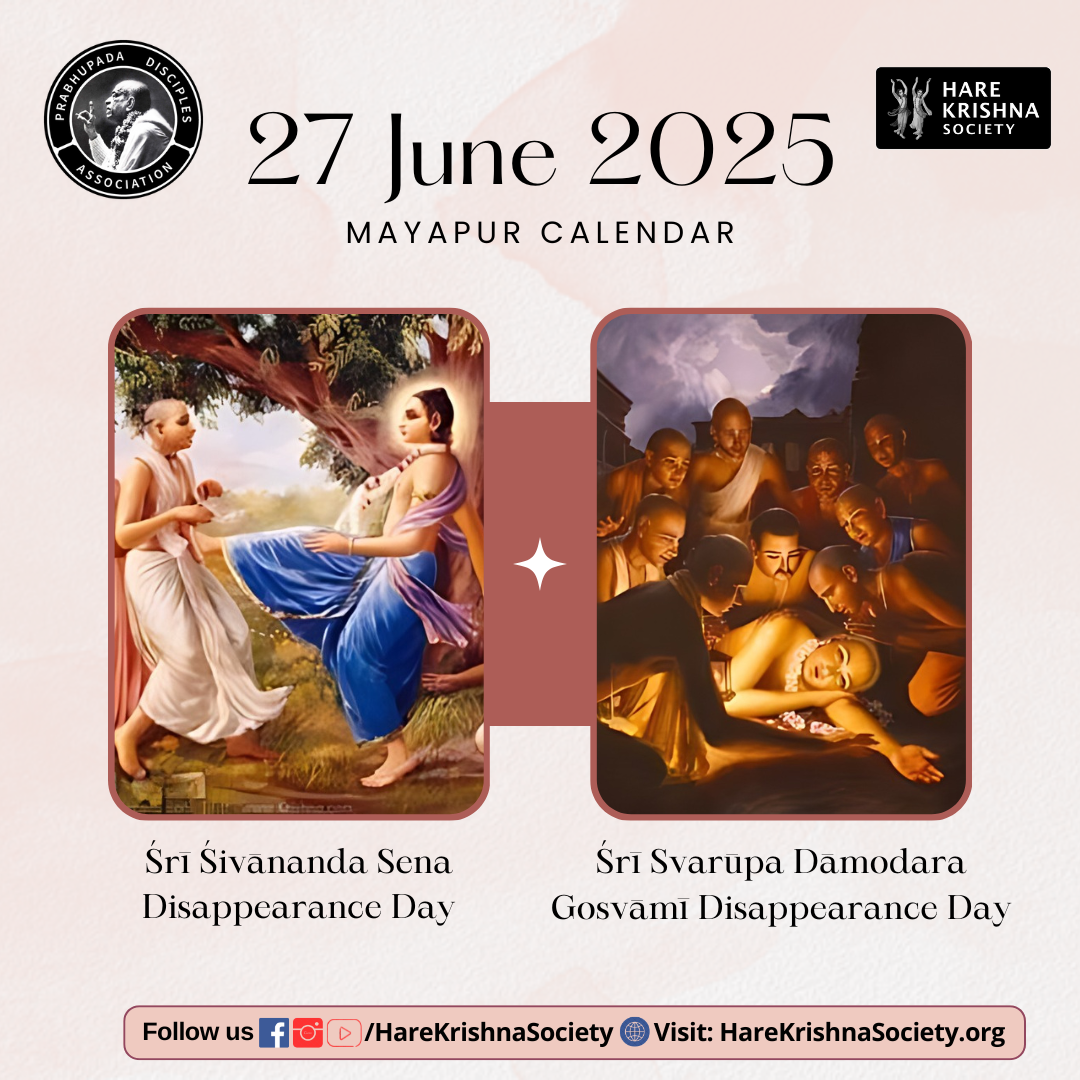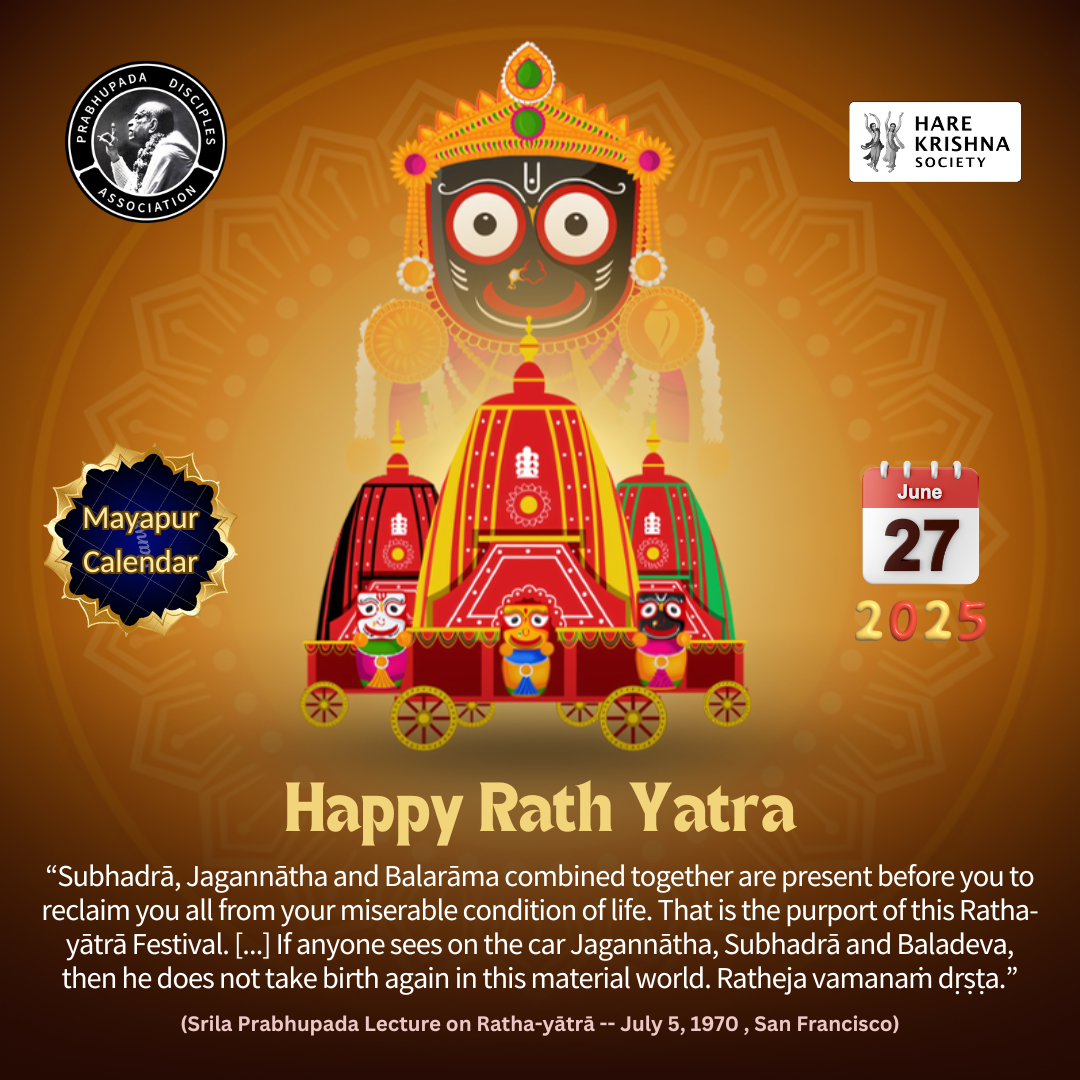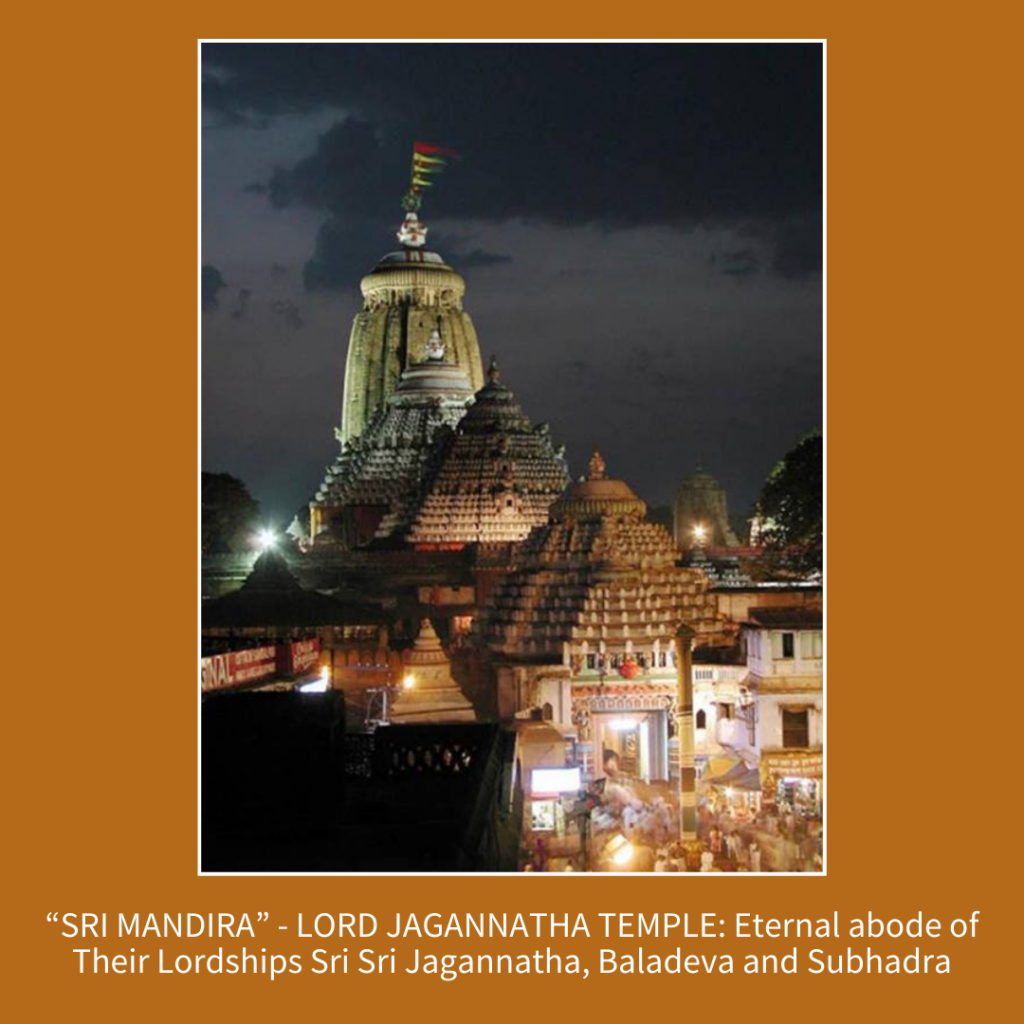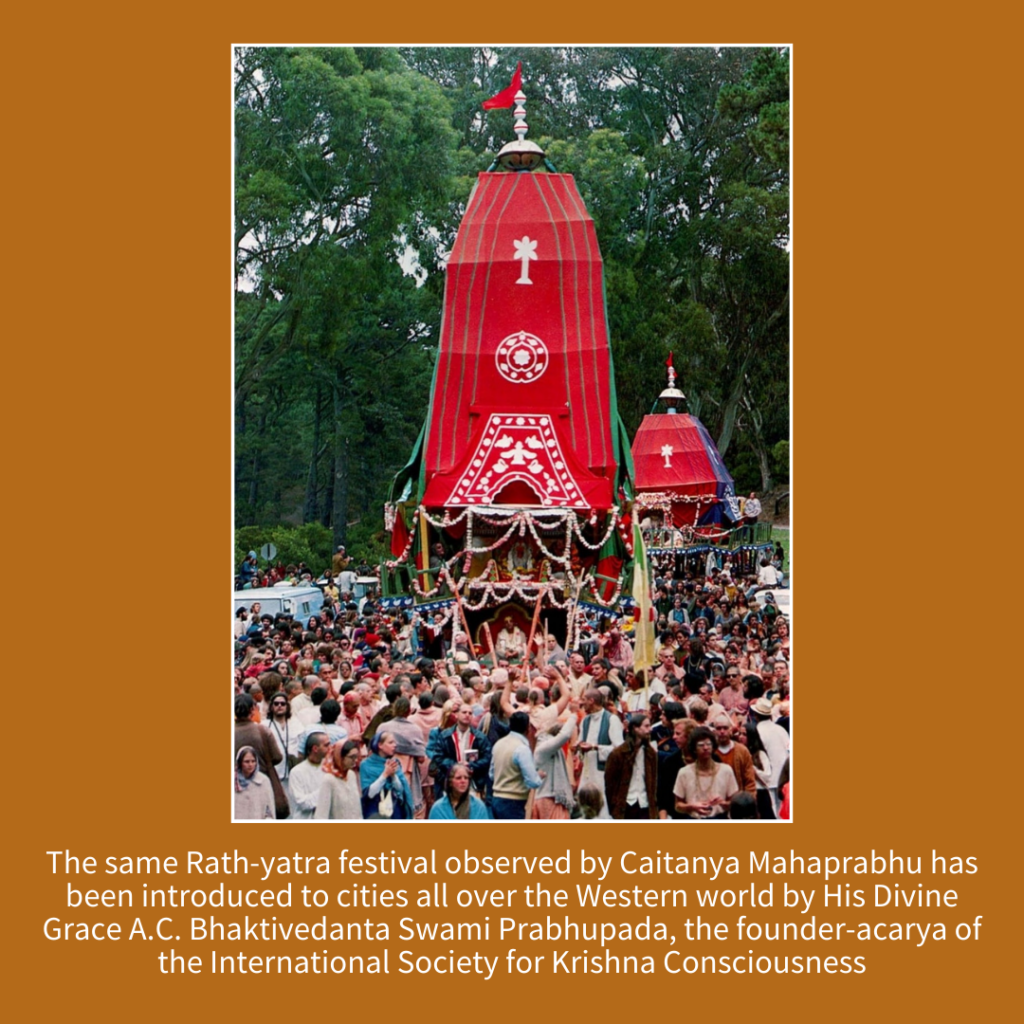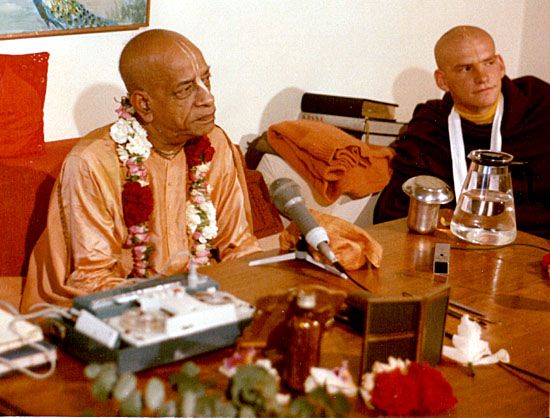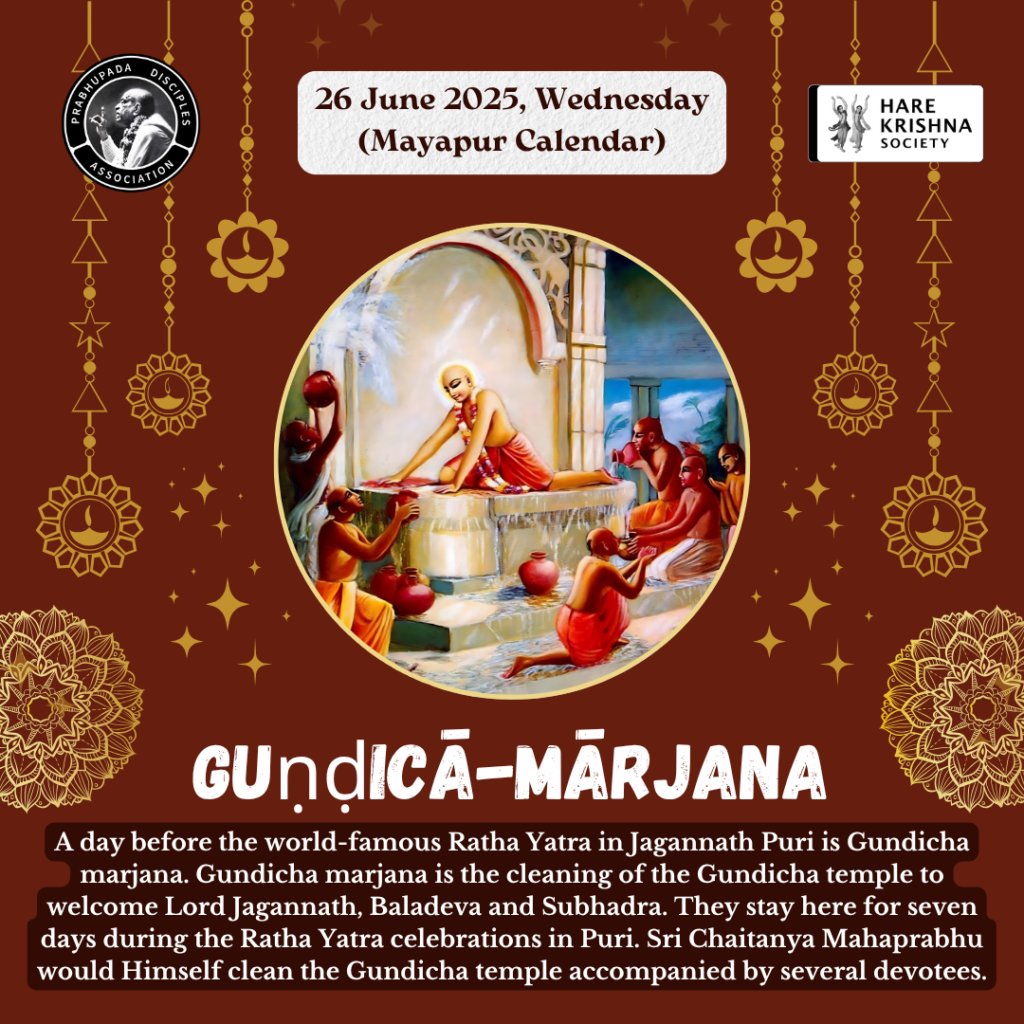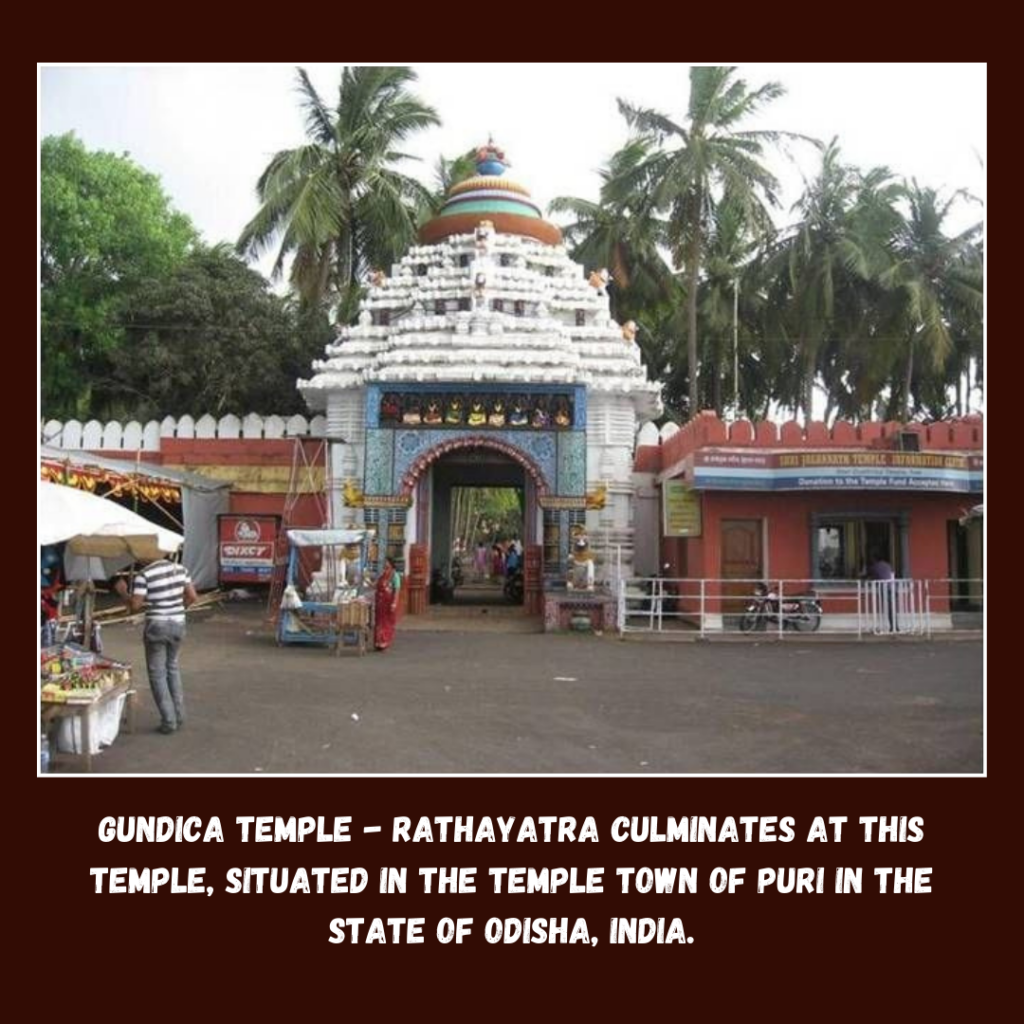By Bhakta Alex

Truth: All Srila Prabhupada’s answers in the minutes book were misstated by the secretary, so it has wrong information which contradicts both actual evidence- audio recording of May 28th conversation and what happened later- the only appointment was in July 1977, and it was appointment of first ritviks. The minutes weren’t shown to Srila Prabhupada and approved by him, and circumstances around it prove that Srila Prabhupada’s instructions on initiations were mishandled/concealed. By Bhakta Alex, Russia.
In some anti-ritvik papers and videos, one document is incorrectly interpreted and overly emphasized- the minutes book of May 28th 1977, GBC meeting. For example, the pages of the protocol were published in ISKCON Journal in 1990, in ITV film “Disciple of My Disciple” (1999), it was quoted in articles by Hari Sauri das, in official GBC paper “Prabhupada’s Order” (August 1998), etc.
1. How were the minutes made on May 28, 1977?
In 1999, the GBC funded video “Disciple of My Disciple” was released and distributed in maya-ISKCON temples. In particular, Tamal Krishna was shown in this film to give great importance to this document, but in the previous episode, another maya-ISKCON “guru” Giriraja explained how it happened that GBC members signed the minutes of the extraordinary meeting held at the end of May 1977 in Vrindavan that was called upon Srila Prabhupada’s announcement that his health seriously deteriorated and it’s necessary to discuss some issues in case Srila Prabhupada passes away.
Giriraja: “And one of the questions was how the process of initiation would go on after Srila Prabhupada’s departure. So, some of the members were delegated to represent the group and ask the questions to Srila Prabhupada. Satsvarupa Maharaja was the spokesman for the group. So, we formulated the questions, Satsvarupa Maharaja and others went to the room and asked Srila Prabhupada… So Satsvarupa Maharaja came out and told us about Srila Prabhupada’s answer to question about initiations in the future. Satsvarupa Maharaja said very simply that some of us would become gurus and give initiation, and the disciples we initiated would be our disciples and they would be Srila Prabhupada’s granddisciples.” (Disciple of My Disciple video, https://www.youtube.com/watch?v=liBoHUJyxHU)
But according to the official audio recording of the conversation, Srila Prabhupada actually answered something different: he would appoint ritviks, not diksa gurus, for the period after his departure, and the future disciples would be his disciples, and when asked further he said that disciple of his disciple, his granddisciple would be possible when he orders someone, “You become guru”, that’s all (which didn’t happen in 1977, but the appointment of first ritviks did).
However, immediately after the release of the above film, a detailed refutation was published. A relevant quote:
“The Value of The GBC Minutes Book as Evidence
Tamal Krishna Maharaja makes a big issue of the fact that the minutes were signed by 17 GBC members. However, earlier Giriraja Maharaja, one of the signatories, admits that he gained his understanding of what Srila Prabhupada said from Satsvarupa Maharaja, who came out to inform them of what transpired in the meeting. Giriraja, and those GBC’s who were with him, then signed the minutes book based only on the secondhand testimony of a man who then went on to lead the zonal acarya deviation, for almost an entire decade, and who, as we have just seen, is still extremely confused even today. So, the GBC minutes are signed by two groups of people.
1. The handful of GBCs who had been in the room with Srila Prabhupada and completely misunderstood what he wanted,
2. The remaining GBC’s who signed the minutes on the basis of what the first group, led by Satsvarupa Maharaja, told them. Hardly impressive evidence. The real record of the May 28th conversation is the tape itself.”
(From A response to ISKCON TV (ITV)’s ‘Disciple of My Disciple’ video by IRM, https://www.iskconirm.com/docs/webpages/Reply_ITV.htm)
Srila Prabhupada wrote:
“Now has the GBC become more than Guru Maharaja?” (SP Letter to: Alanatha — Bombay 10th November 1975)
“So how is it that the GBC are the final authority?” (SP Letter to: Umapati — Los Angeles 9th July 1971)
It’s Srila Prabhupada, not the GBC, who is ISKCON’s supreme authority in all matters, according to ISKCON pre-1978 documents. From the GBC’s founding document Direction of Management, 1970, section PARTICULARS OF THE GOVERNING BODY COMMISSION:
“The purpose of the Governing Body Commission is to act as the instrument for the execution of the Will of His Divine Grace. And further,
1. The GBC oversees all operations and management of ISKCON, as it receives direction from Srila Prabhupada, and His Divine Grace has the final approval in all matters.”
So, Srila Prabhupada’s actual recorded words and documents signed by him have more importance than any GBC minutes.
2. Strange wording of GBC questions
On May 28th 1977, GBC members prepared 5 questions to deal with 3 topics: the GBC, the guru/initiation system, and translation of new Vaisnava books and their publication by the BBT in the future. The list was recorded in the GBC minutes book, which was published in ISKCON Journal in 1990, pg. 4:
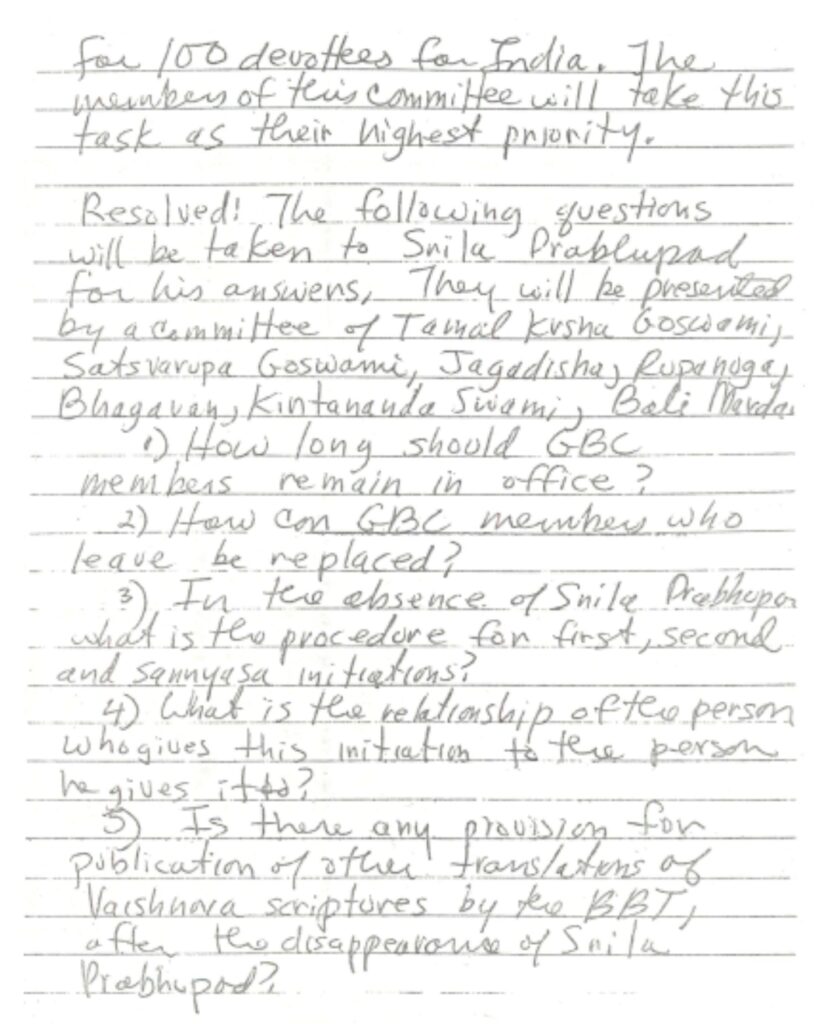
“Resolved: The following questions will be taken to Srila Prabhupad for his answers. They will be presented by a committee of Tamal Krsna Goswami, Satsvarupa Goswami, Jagadisha, Rupanuga, Bhagavan, Kirtanananda Swami, Bali Mardan.
1) How long should GBC members remain in office?
2) How can GBC members who leave be replaced?
3) In the absence of Srila Prabhupada what is the procedure for first, second and sannyasa initiations?
4) What is the relationship of the person who gives this initiation to the person he gives it to?
5) Is there any provision for publication of other translations of Vaishnava scriptures by the BBT, after the disappearance of Srila Prabhupada?”
The first two questions relate to the GBC, and it seems that question #1 was connected to Direction of Management as it’s the only official paper signed by Srila Prabhupada that delineated their 3-year term. Why they didn’t mention the DOM directly and ask Srila Prabhupada if its provisions should be implemented in the future, or they should be amended? Did anybody among GBCs mention at the meeting something about what to do with the DOM that was being included in some of the bylaws (ISKCON Bay Area, etc.) on Srila Prabhupada’s direct instructions? Or did some of them want the DOM to be forgotten and discarded so that there will be no restrictions on their GBC positions?
What was Tamal Krishna’s role in preparing the original 5 questions for 28 May discussion with Srila Prabhupada? Did Tamal try to influence their formulation? According to April 22nd 1977 conversation, he already was thinking who could be Srila Prabhupada’s successor, and he concluded that all of them were conditioned souls. He must have thought a lot about the upcoming GBC meeting and the questions that should be asked to Srila Prabhupada since His Divine Grace announced on May 17 that he came to Sri Vrindavana-dhama to leave his body and called GBCs to come.
In the course of GBC discussion, was there any mention of initiations via representative system? Otherwise, why they included questions #3 & #4 about initiations? Why ask “what is the relationship of the person who gives this initiation to the person who gives it to”? As Tamal himself confessed on December 3rd, 1980, in Topanga Canyon, “What actually happened was that Prabhupada mentioned he might be appointing some ritviks, so the GBC met for various reasons, and they went to Prabhupada, five or six of us [on May 28th 1977].” So, he, due to being Srila Prabhupada’s secretary since February 1977, was the most informed of all the GBC members. On about May 24/25, 1977, he already heard from Srila Prabhupada that he was not going to appoint any successor gurus, but would appoint ritvik-representatives (according to Srila Prabhupada’s personal servant Gauridas Pandit das). Tamal should have told the GBCs that Srila Prabhupada indicated this decision.
Also, why did they decide to send several men delegation to Srila Prabhupada? All the GBCs could visit Srila Prabhupada, and witness his answers and seek for any clarification, as it was their duty. Srila Prabhupada’s room wasn’t so small, so why they decided to send a small delegation? They could have arranged the meeting in a series of conversations in case Srila Prabhupada was too ill (to let him rest as necessary). But they all could have visited him and clarify all the details before ending the GBC meetings.
Rupanuga das declined to answer the above questions. Is there any other remaining GBCs of that time who can answer these points?
3. Strangely asked questions during the conversation
As shown in previous myth-busting article dedicated to May 28th 1977 conversation, Satsvarupa and Tamal asked some confused questions. For example:
6. Prabhupāda: He’s guru. He’s guru.
7. Satsvarūpa: But he does it on your behalf.
Above Srila Prabhupada talked of himself since he was asked in the third person (“that person”), but in Satsvarupa’s remark by “he” the ritvik is meant. Also, he didn’t inquire more about Srila Prabhupada’s opening answer (like what is ritvik, etc., but just moved on to the next prepared question). As a result, the section of the conversation that dealt with future initiations was short, just 2 minutes long. Also, in question #3, Satsvarupa didn’t mention sannyasa initiations despite the fact it was agreed upon and written in the GBC questions list. Earlier, he started off by asking about the “original” (12 GBCs from 1970) in the section where the future of the general body of the GBC members should have been discussed (as per GBC’s prepared list), etc.
Nityananda das: “Why did they not ask Srila Prabhupada proper questions such as:
(1) “After your departure, will the GBCs be elected by temple presidents as prescribed in the DOM?”
(2) “Are you amending the DOM’s provisions for 2/3 of the GBC to be elected every three years by the temple presidents?”
They never asked these questions. The ISKCON hijackers feared for their future GBC posts… They interpret the short May 28th conversation to suit their corrupt agenda.”
Regarding Satsvarupa’s condition of that time:
HENRY DOKTORSKI: “May 28th 1977: On this date in history 46 years ago, senior disciples meet with Bhaktivedanta Swami Prabhupada to discuss how initiations of new disciples are to be conducted in the future.
ON THE DAY FOLLOWING Bhaktivedanta Swami Prabhupada’s warning that men will pose as guru and attempt to take over ISKCON, eighteen leading disciples met with their spiritual master, in his personal quarters at Krishna Balarama Mandir in Vrindaban, especially to inquire about the process for initiating new disciples in the future. Satsvarupa dasa Goswami (Stephen Guarino)—the GBC representative for Miami, Gainesville, Houston, Dallas, St. Louis, Denver and Berkeley, and editor-in-chief of Back to Godhead magazine—was chosen as spokesman. Tamal Krishna Goswami, Prabhupada’s secretary at the time, also spoke up frequently during the conversation.
A GBC sub-committee had selected five questions to ask Bhaktivedanta Swami Prabhupada: (1) How long should GBC members remain in office? (2) How can GBC members who leave be replaced? (3) In the absence of Srila Prabhupada what is the procedure for first, second and sannyasa initiations? (4) What is the relationship of the person who gives this initiation to the person he gives it to? (5) Is there any provision for publication of other translations of Vaishnava scriptures by the BBT after the disappearance of Srila Prabhupada?
Unfortunately, Satsvarupa was not able to clearly articulate the third and fourth questions which the GBC subcommittee had commissioned him to ask. Later, he confessed that he felt “shy and uneasy” and “foolish and awkward” during this important conversation with his spiritual master. Consequently, Satsvarupa’s questions were difficult to understand.” (Gold, Guns and God, Vol. 3, pg. 203, Eleven Naked Emperors, pg. 30)
In his paper “A Memoir of 1977” dated January 1990 Satsvarupa wrote: “That interview with Srila Prabhupada of May 28th 1977… I can remember my own state of mind: grief-stricken, afraid, half-numb.”
At the end of his paper Satsvarupa adds a notion regarding an incident that occurred in late 1977: “Then in October Srila Prabhupada again became very critical in his health, and many of us went again to see him for the last time. In this connection, I have another relevant memory of something that occurred in the very last days of Prabhupada’s stay. I was talking with Jayadvaita Maharaja in a room in the quest house at Krishna-Balarama Mandira. I expressed to him my understanding that the list of persons who Prabhupada had picked to initiate on his behalf, was also the list of persons who Prabhupada had promised he would pick in May when he said he would appoint some of his disciples who would initiate their own disciples [wrong: not their own, but Srila Prabhupada’s disciples] after Prabhupada’s disappearance.
I don’t think that Jayadvaita Maharaja disagreed with me. But he did say strongly that I had better get this in writing from Srila Prabhupada. He said this was very important and that it was really not clear. He said that unless it was in writing it would be contested by devotees later. I was surprised to hear that because it seemed quite clear to me [to confused Satsvarupa who was self-admittedly “grief-stricken, afraid, half-numb” during the May 28th 1977 conversation, and who became a leader of the zonal acarya system in 1978, that was officially discarded as “unauthorized” system years later, and ultimately Satsvarupa sexually fell-down and got under psychiatric treatment while being a “guru”]. But Jayadvaita Maharaja insisted that I should get it in writing from Prabhupada.
So, on his advice I thought he must be right that it was very serious. I went down to Tamal Krishna Maharaja and asked him about it. […] I asked Tamal Krishna Maharaja to please get this [supposed appointment of new diksa gurus] in writing [from Srila Prabhupada]. He asked, “Why?” I said, “Because people will not understand that Prabhupada picked the regular gurus when he named the persons who would initiate while he was still with us.” Tamal Krishna Maharaja replied that he himself knew very well what Prabhupada intended, and that was good enough for him. I tried to ask him to ask Prabhupada to sign something. But Tamal Krishna Maharaja was not willing.”
Isn’t it suspicious behavior on the part of Tamal? Jayadvaita said it’s unclear and it’s very important, Satsvarupa agreed to try and get this confirmed, but Tamal says, “Why?” What an answer, “He himself knew very well what Prabhupada intended and that was good enough for him”. This incident is just another evidence of very strange behavior of Tamal and co. who were preparing the coup.
Unfortunately, Satsvarupa was misled by the group that turned to the dark side. Also, if Jayadvaita and Satsvarupa understood it was “very important” to get the supposed appointment of new diksa gurus in writing so that it wouldn’t be contested, then Srila Prabhupada certainly would have understood that long ago and put it in writing! But he didn’t do it because by that time he had already put in writing his real decision: the ritvik system to continue functioning on his behalf.
Amazingly, Satsvarupa himself describes just another of many episodes of Tamal’s fishy dealings in 1977, but at the end concludes there couldn’t be a “deliberate conspiracy to disobey Srila Prabhupada”. Satsvarupa tries to downplay Tamal’s actions by referring to intense emotional situation. But if you say that Tamal, Satsvarupa himself, etc. were basically in affected state of mind, then how can you simultaneously claim that they definitely understood Srila Prabhupada’s appointment of new diksa gurus?
So, the bottom line is Satsvarupa was confused during the May 28th 1977, conversation (and later on) and was misled by Tamal- the mastermind of the conspiracy. Therefore, the questions were asked in a quite strange way, and Tamal kept silent of what he knew from previous conversation(s) about the ritvik issue. It seems that other present GBC delegation members were either themselves confused or were a part of the conspiracy. One of them, Bhagavan dasa, wrote in his letter dated Gaura Purnima 2000:
“I must admit that although it was our duty to clarify these very pivotal issues for posterity, to concentrate on asking him these terribly painful questions about what to do if he should no longer be present, was so spiritually borderline, repulsive and bizarre to me, that I found myself in an incredulous state of mind and not fully present.”
4. Srila Prabhupada’s answers were recorded in the GBC report in an odd way: they do not correspond to the words on the tape, nor were they shown to Srila Prabhupada and signed by him
After the GBC delegation’s conversation with Srila Prabhupada, Satsvarupa wrote down the three supposed answers of Srila Prabhupada in the minutes book:
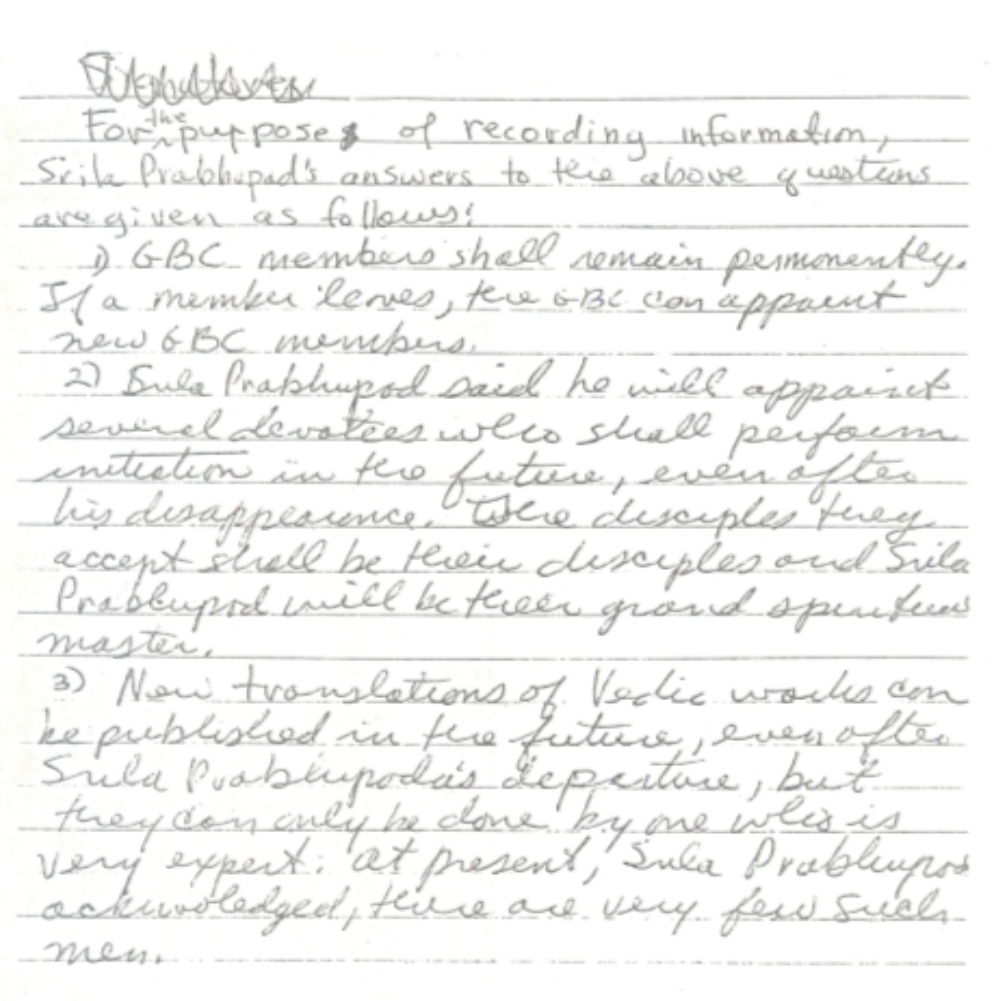
Below the answers, there are signatures of 18 GBC members dated May 28, 1977:
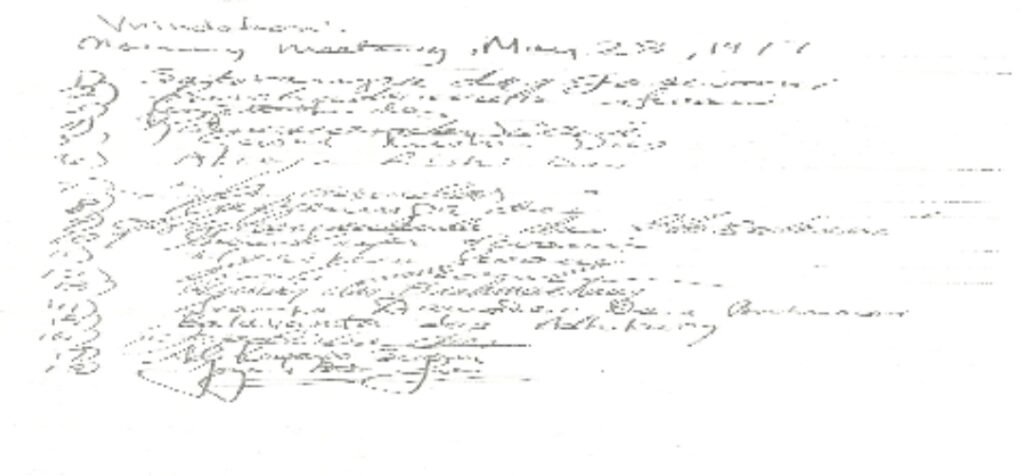
But Satsvarupa just came out of the room and told the other GBCs what were Srila Prabhupada’s answers. So, the majority of the GBCs got their understanding from Satsvarupa who was confused himself. In a video, Rupanuga das mentioned that Tamal stayed for a while in Srila Prabhupada’s room and therefore he didn’t sign the minutes. So why the GBCs, in such grave circumstances, didn’t ask to listen to the tape and just signed something they weren’t witnesses to? Also, didn’t they get any further questions after hearing that Srila Prabhupada supposedly promised to appoint new initiating gurus of the sampradaya? Or when July 9th 1977, directive announced the appointment of first ritviks (not diksa gurus)?
Let’s review Srila Prabhupada’s supposed answers written in the minutes:
“For the purpose of recording information, Srila Prabhupad’s answers to the above questions are given as follows:
1) GBC members shall remain permanently. If a GBC member leaves, the GBC can appoint new GBC member.”
The GBC related section of the conversation was quite ambiguous. Why GBC members didn’t ask anything regarding ISKCON constitution document- Direction of Management? Instead of “GBC members shall remain permanently” the minutes should have stated “The original GBC members shall remain permanently.”
Nityananda das: “Rather than an “effective amendment” which negated the DOM’s GBC elections by temple presidents, what we do have from the 1975 GBC resolution and the May 28th talks are FIVE minor GBC election clarifications, but which do not change the DOM:
(1) “No changes” to the GBC meant that only Srila Prabhupada would make any changes- only he would select, remove GBC members.
(2) The GBCs that Srila Prabhupada selected would “remain” for life, if competent and “acharya-like.” By 2024 only two GBCs appointed by Srila Prabhupada remained (Gopal Krishna, Jayapataka Swamis), so they are “for good.” But if they “deviated” since 1978, this is a criteria to evaluate their fitness for office. However, all other “post-Prabhupada” GBCs must face elections as per the DOM.
(3) As long as Srila Prabhupada was selecting GBCs himself, there would be no elections, but after he departed there would need to be elections of some kind, or how would the GBC go on?
(4) Competent candidates for GBC “can be selected to act by the board of the GBC” may simply refer to 1/3 of GBC’s elected by the GBC. This does not change the 2/3 GBCs elected by temple presidents.
(5) Elections were only delayed until Srila Prabhupada departed, then DOM elections would become effective, not “ineffective.”
The next sentence in the minutes is also incorrect: “If a GBC member leaves, the GBC can appoint new GBC member.” Srila Prabhupada answered, “Another should be elected.”
Nityananda das: [But elected by whom? Srila Prabhupada, the GBC, or as per the DOM? It appears Srila Prabhupada is talking about his own selections.]
Sats: By the votes of the present GBC.
[Satsvarupa says this quietly, under his breath, without acknowledgement from Srila Prabhupada. He goes quickly to the next question and Srila Prabhupada did not confirm that the GBC would elect its own future members, and may not have even heard his mumblings.]
So, Satsvarupa incorrectly “recorded” the answers to the first question in the GBC minutes. See detailed analysis in ‘TRUSTING SRILA PRABHUPADA’, Personal Ambition series, vol 8, ch. 10-11.
Similarly, the second answer was wrongly reported:
“2) Srila Prabhupada said he will appoint several devotees who shall perform initiation in the future, even after his disappearance. The disciples they accept shall be their disciples and Srila Prabhupada will be their grand spiritual master.”
It should have been worded in accordance with real words of Srila Prabhupada, like this:
“2) Srila Prabhupada said he will appoint several devotees as ritviks who shall perform initiation in the future, even after his disappearance. The disciples they accept shall be Srila Prabhupada’s disciples. They can become regular gurus with their own disciples, granddisciples of Srila Prabhupada when His Divine Grace orders so.”
Note how strangely it is worded in the minutes. The first sentence implies that spiritual masters would be appointed to perform initiations in the future, “even” after his departure. That means they will begin acting as diksa gurus in Srila Prabhupada’s presence, and will continue after his departure. But this is a contradiction to:
a) what Srila Prabhupada had taught regarding etiquette of not becoming diksa gurus in the presence of one’s own guru (e.g. “as a matter of etiquette it is the custom that during the lifetime of your Spiritual master you bring the prospective disciples to him” SP Letter to: Tusta Krsna — New Delhi 2nd December, 1975);
b) what was said in May 28th conversation itself, “in my presence one should not become guru “;
c) what happened in reality: later on, in July 1977, they were appointed as ritviks only, not as diksa gurus who would accept their only disciples in the future, “even” after his disappearance; not as ritviks until departure and then diksa gurus. Just as ritviks for the future.
Ritviks before departure are not against Srila Prabhupada’s teaching. E.g. a spiritual master and his ritviks can act at the same yajna:
“Acting as Supersoul, the Lord gives inspiration to a suitable person to perform the Vedic ritualistic ceremonies. In this connection, four classes of priests, known as ṛtvik, are required. They are mentioned as hotā, adhvaryu, brahma and udgātā.” (Srimad-Bhag.7.3.30)
“One should satisfy the spiritual master [ācārya], who is very learned in Vedic literature, and should satisfy his assistant priests [known as hotā, udgātā, adhvaryu and brahma]. One should please them by offering them clothing, ornaments and cows. This is the ceremony called viṣṇu-ārādhana, or worship of Lord Viṣṇu. O most auspicious lady, one should perform all the ceremonies under the direction of learned ācāryas and should satisfy them and their priests. By distributing prasāda, one should also satisfy the brāhmaṇas and others who have assembled. One should satisfy the spiritual master and assistant priests by giving them cloth, ornaments, cows and also some monetary contribution. And by distributing prasāda one should satisfy everyone assembled, including even the lowest of men, the caṇḍālas [eaters of dog flesh].” (Srimad-Bhag. 8.16.53-55)
Ritviks after departure are also consistent with Srila Prabhupada’s instructions (e.g. modern followers of Jesus Christ who can be liberated by their savior, as is said by Srila Prabhupada in ‘Perfect Questions, Perfect Answers’).
But diksa gurus before the departure of one’s guru are against Srila Prabhupada’s warnings to his disciples. Diksa gurus after departure are not against his teaching only if highly qualified, and authorized by Sri Krishna through one’s own guru.
So which version is more consistent with what actually happened? Definitely the first (ritvik) one. This again shows that the statement #2 in the GBC minutes was fatally flawed.
In addition, the protocol says that Srila Prabhupada replied he was going to appoint initiating gurus with their own disciples. But in July 9th directive, Tamal, as Srila Prabhupada’s secretary, wrote something different:
“Recently when all of the GBC members were with His Divine Grace in Vrndavana, Srila Prabhupad indicated that soon He would appoint some of His senior disciples to act as “rittik”—representative of the acarya, for the purpose of performing initiations, both first initiation and second initiation”. (July 9th 1977 directive to all ISKCON Temple presidents and GBCs, signed by Srila Prabhupada)
That is, Tamal, who, among other disciples, was the most well-informed participant in the conversations with Srila Prabhupada of that period, and who heard more 1977 discussions with His Divine Grace than anyone else, clearly understood (as he admitted on December 3rd 1980) that on May 28th, as well as on previous and subsequent days and months, Srila Prabhupada spoke of appointment of ritviks only who would accept Srila Prabhupada’s disciples, and “it was never any more than that”.
Another contradiction: according to the minutes, Srila Prabhupada allegedly said he would appoint initiating gurus. Since 1978, it has been put into practice and propagated that it’s being done on Srila Prabhupada’s order. But then, during the guru reform of the mid-1980s and in many future papers and confessions, they agreed it was a misunderstanding of “zonal acaryas” era, because Srila Prabhupada didn’t actually “appoint” anyone as diksa guru. So, those anti-ritviks who still put forward the GBC minutes as an argument in favor of their position, in fact, advocate the myth of 11 zonal acaryas appointment, which is currently officially considered a prohibited doctrine even in maya-ISKCON.
More contradictions: paragraph #2 of the minutes book claims Srila Prabhupada allegedly said he would appoint initiating gurus with their own disciples, but paragraph #3 says there are very few such men who are qualified to translate the scriptures. And in the printed version, this phrase is changed to “at present, Prabhupada acknowledged, there is no one yet qualified.” In late 1977 – spring of 1978, the eleven began accepting their own disciples as guru successors allegedly appointed by Srila Prabhupada. But what kind of diksa gurus were they, if they were not qualified to translate the scriptures? In the May 28th, 1977, conversation, Ramesvara said that none of Srila Prabhupada’s disciples are qualified to translate the sastras, and Srila Prabhupada said this was a “good answer.”
Prior to that, on April 22nd, 1977, TKG said he had studied all of Srila Prabhupada’s disciples and it was obvious that they were still conditioned souls, so they could not be diksa gurus. On May 27th 1977, Srila Prabhupada said, “Among yourselves, there is no strong man. That is the defect. All like child. That is the defect. And it requires a very strong man. That is lacking.” Later in 1977 Bhavananda said to Srila Prabhupada, “And you told us at that time, “You are all children. None of you has any intelligence.” That was only five months back. We have not grown that much in five months. We’re still children. You have always practically directed us in every one of our activities. And where we followed your instructions, there we have been successful. But because we are only children, sometimes we…” (Room Conversation — October 26th 1977, Vṛndāvana).
Satsvarupa himself wrote in his 1977 book ‘Readings in Vedic Literature – The Tradition Speaks for Itself’ (approved by Srila Prabhupada) that a guru should be a self-realized soul, a perfect devotee. So, how children, conditioned souls, unqualified to translate the scriptures due to lack of spiritual realization could at the same time be appointed as diksa gurus who ought to be perfect devotees? Srila Prabhupada taught that bona fide spiritual masters do not deviate but bogus gurus do degrade, and endless scandals of maya-ISKCON “gurus” have definitely proved they were not authorized as diksa gurus in the first place.
Unfortunately, the GBC members didn’t think or didn’t took it seriously that there are a number of contradictions regarding the alleged appointment as a diksa gurus. Why was this issue not clarified by them from Srila Prabhupada in more detail?
Also, it should be noted that the minutes book states, “Srila Prabhupada said he will appoint several devotees who shall perform initiation in the future”. Then how maya-GBC can claim in their official paper “Disciple of My Disciple” (1997) that Srila Prabhupada authorized new diksa gurus there and then during May 28th 1977, conversation:
“The present paper will show that on May 28th, 1977, Srila Prabhupada ordered his disciples to become initiating spiritual masters.” (pg. 2)
What it shows is that they are swamped in contractions.
The third answer’s wording in the minutes is also questionable:
“3) New translations of Vedic works can be published in the future, even after Srila Prabhupada’s departure, but they can only be done by one who is very expert. At present, Srila Prabhupada acknowledged, there are very few such men.”
Actually, Srila Prabhupada said:
Satsvarūpa: Next we have a question about the BBT. At present, no translation work is to be published without your seeing and approving it. So, the question is, is there any system for publishing works in the future that you may not see? For example, we’ve heard suggested that the Padma Purāṇa or the Ṣaṭ-Sandarbha may be translated. But what would the system be to insure the paramparā, if you would not personally see these translations?
Prabhupāda: That you have to examine expertly. […] Similarly, if somebody has translated properly, it can be published. But amongst our disciples, I don’t think there are many who can translate properly.
Rāmeśvara: None. We’re not eager to publish anything which is not perfect, because you have already set the highest standard for the BBT. The name BBT means the highest standard right now in the world.
Prabhupāda: That is good answer.
Kīrtanānanda: Therefore, Śrīla Prabhupāda, we think that you cannot leave us very soon.
Prabhupāda: I don’t want. But if I am obliged, what can I do?
Kīrtanānanda: If you don’t want, Kṛṣṇa will not want.
Prabhupāda: A realized soul, must be. Otherwise, simply by imitating A-B-C-D will not help. My purports are liked by people because it is presented as practical experience. […] Our translation must be documents. They are not ordinary… One cannot become unless one is very realized. It is not A-B-C-D translation.
Bhagavān: It’s not a matter of scholarship. (GBC Meets with Śrīla Prabhupāda — May 28th 1977, Vṛndāvana)
From the above it seems that more correct conclusion is that no one among the disciples was really qualified. And it is exactly how the printed version of the GBC report was changed to from the handwritten version:
“New translations of Vedic works can be published in the future, even after Srila Prabhupada’s departue, by the BBT but they can only be done by one who is very expert and advanced in his realization. At present, Prabhupada acknowledged, there is no one yet qualified.”
So, the GBC factually admitted their handwritten version of this answer was incorrect. Again, if “there is no one yet qualified” to make proper translation of Vedic literature then how can they be appointed as initiating gurus? It’s a glaring contradiction: translation must be done by a “realized” soul, but that is lacking, still for becoming a diksa guru (who must also be a realized soul, as Srila Prabhupada had taught) they are supposedly fit. However, Srila Prabhupada’s real words on the tape don’t have such contradiction.
Thus, all three answers more or less incorrectly conveyed Srila Prabhupada’s instructions that he actually spoke. It’s strange that neither the minutes, nor the printed GBC report to ISKCON regarding the meeting were shown to Srila Prabhupada for his approval. Previously, all the resolutions that GBC passed were then to be read to Srila Prabhupada for his possible correction and final approval. Why the GBCs didn’t do the same in May 1977?
One may argue that this GBC man was personally there, that GBC, such and such GBC, how could they didn’t detect the discrepancies and contradictions? But that is not impossible. We can recall Srila Prabhupada’s letter about the GBC meeting where unconstitutional decisions were made to centralize ISKCON management, and as a result the GBC body was temporarily suspended by Srila Prabhupada:
“The meeting of the GBC appeared to be very unconstitutional, because all the men were not informed or invited. Syamasundara was not invited, Sudama was not invited, Krishna das was not invited, Tamala Krishna was not invited, neither I was informed. Why? You cannot hold meeting of 8 persons without inviting the others. Seven may be a quorum, that’s all right, but you cannot convene without a general announcement to all the members and myself, giving a proposed agenda, like that, the topics to be discussed, why the meeting is being called, etc. Then there is correspondence for deciding these things, and if there is great necessity, then meeting may be called, but not whimsically, only after much thought is given and there is clear intimation of all the members plus myself. Anything whatever is done is done, but the whole thing appeared to be giving all power to Atreya Rsi. I cannot understand why, instead of one GBC man, a person outside the Commission was given so much power, and there was to be immediate action without divulging the matter to the devotees. And I am surprised that none of the GBC members detected the defects in the procedure. It was detected only when it came to me. What will happen when I am not here, shall everything be spoiled by GBC? So, for the time being, let the GBC activities be suspended until I thoroughly revise the whole procedure.” (SP Letter to: Hamsaduta — Sydney 11 April, 1972)
5. Strange difference between handwritten and printed versions of the GBC report: the initiations paragraph was completely deleted!
But the above-mentioned change to the BBT related answer wasn’t the only difference between the handwritten minutes and the typed GBC report to the rest of ISKCON: out of three answers in the minutes they presented just two of them in the summary report to ISKCON: regarding GBC and BBT. But the initiation question/answer was omitted altogether!
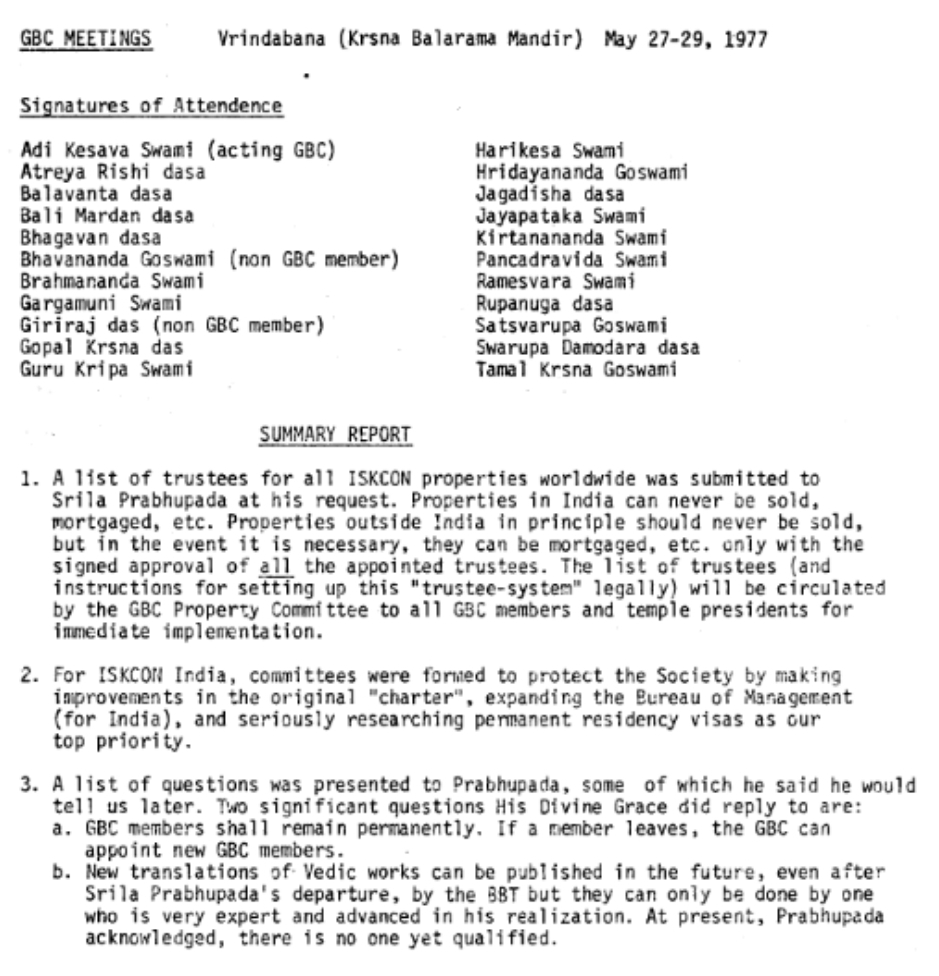
“3. A list of questions was presented to Prabhupada, some of which he said he would tell us later. Two significant questions His Divine Grace did reply to are:
a. GBC members shall remain permanently. If a member leaves, the GBC can appoint new GBC member.
b. New translations of Vedic works can be published in the future, even after Srila Prabhupada’s departure, by the BBT but they can only be done by one who is very expert and advanced in his realization. At present, Prabhupada acknowledged, there is no one yet qualified.” (End of quote from the GBC’s printed “Summary Report”)
There should have been three points (a, b, c), not two. Despite requests, the GBC has never clarified why the printed version of the May 27-29, 1977, GBC report that was sent out through the BBT newsletter to ISKCON differs from the handwritten minutes? Was this a result of some additional negotiations between some of the GBC members? Why the issue of future initiations/ritviks/gurus was completely deleted in the printed version? Who made this omission/change?
Nityananda das: “Note that in #3 above, the points on initiations in the future are omitted. Why? Because they knew Srila Prabhupada did NOT want succeeding acharyas or regular initiating gurus, but only officiating or ritvik acharyas. This is deliberate concealment. They wanted these talks hidden and suppressed, and then after Srila Prabhupada departed, they could have the GBC body, which they controlled, falsely claim that Srila Prabhupada appointed them as successor acharyas. It was a takeover conspiracy which they actually executed successfully. We can imagine the zealous questions and furor that would erupt IF these notes were posted society-wide. But they were not, and this is a premeditated conspiracy to keep the May 28th discussions HIDDEN. If devotees did not know of the May 28 talks, there could be no discussions about it, no clarifications sought from Srila Prabhupada, and then after Srila Prabhupada’s departure, claims could be made (and they were made) about what Srila Prabhupada supposedly wanted for the future. It was a takeover conspiracy.” (From ‘Srila Prabhupada’s Hidden Glories’, chapter 84: MAY 28 DISCUSSIONS CONCEALED, pg. 506)
From an interview with Srila Prabhupada’s disciple Locanananda das:
“As president of the Amsterdam temple in 1977, I received the Summary Report of GBC meetings in Vrindaban May 27-29, 1977, where only two of the three questions Srila Prabhupada answered on May 28th were included, and the answer to the third question about future initiations was not. […] There is no question, vital information was withheld from the devotees that was critical to the future of our society. […]
That day, there were 19 GBCs in Vrindaban. To ask the most delicate questions, a six-man committee of original 1970 GBCs went before Srila Prabhupada. The first question was about GBC members and then: “Then our next question concerns initiations in the future, particularly at that time when you are no longer with us. We want to know how first and second initiations would be conducted.” Srila Prabhupada replied immediately, directly and succinctly: “Yes. I shall recommend some of you. After this is settled up, I shall recommend some of you to act as officiating acharya.” [Which Prabhupada then equated with ‘ritvik’] Srila Prabhupada introduced a new term not found in any previous conversation. It described the role of future initiators in ISKCON. I don’t know why the GBC hid this instruction from the devotees. Perhaps it just wasn’t what they wanted to hear. The Summary Report stated that some of the questions the GBC asked Srila Prabhupada would not be answered until later. We now know that to be untrue. He answered all of their questions that day.
The initiations question the GBC asked was not included in the Report. Srila Prabhupada’s answer to that question was that when he would no longer be present, initiations would be performed by officiating acharyas selected from among his leading disciples. The leaders never liked that. […] They have no faith in that instruction. The present GBC thinks it has everything figured out, but as long as they do not accept Srila Prabhupada’s nomenclature, they will be treading water in a sea of speculation. What they need to do is pass a resolution stating that “Henceforward, anyone who initiates in ISKCON will act as an officiating acharya.”
These are Srila Prabhupada’s exact words. Srila Prabhupada certainly did not say, “I shall recommend some of you to act as diksha gurus.” Looking at the flow of the May 28th talks, we see the questioners were interested in a specific outcome, that they would be gurus with their own disciples. This blinding ambition kept them from implementing Srila Prabhupada’s order for officiating acharyas, which was divinely inspired announcement. On one hand, His Divine Grace had to arrange for the continuation of initiations in his worldwide movement without violating the law of disciplic succession. He had to account for the management structure already in place with its GBC and temple presidents whose authority he did not wish to subvert. In a letter to Sivananda Jan. 23rd, 1969, Srila Prabhupada wrote: “The spirit of the disciplic succession may not be changed, but there may be adjustments made to suit the special circumstances.”
Never before in recorded history had a Vaishnava acharya introduced the teachings of Vedic culture and the yuga dharma of Sankirtana to every continent, making devotional service available to the entire human society. The ISKCON vehicle he had created was meant to carry his universal message to every town and village as predicted by Sri Chaitanya Mahaprabhu. The process by which millions of converts would be initiated into our Vaishnava sampradaya had to be established without creating factions, keeping Srila Prabhupada in the center as the devotees’ absolute spiritual authority and object of worship. […]
The current initiation protocols in ISKCON may appear to be bona fide because they are based upon the GBC’s speculative guru-tattva, but they should agree with Srila Prabhupada’s ISKCON-specific managerial instructions as described above. This principle was discussed with Professor Staal in 1970. His Divine Grace wrote: “We have to accept everything favorable to the circumstances. Rejection of other methods in a particular circumstance does not mean that the rejected ones are not bona fide. But for the time being, taking into consideration the age, time and object, methods are sometimes rejected even though bona fide. We have to test everything by its practical result.” So, what is the practical result of the GBC’s three-decade experiment, complete with fallen gurus, bogus re-initiations, luxurious life-styles, and all sorts of felonious activity? In one word: devastation. The GBC rejects Srila Prabhupada’s May 28th opening answer on officiating acharyas and jump to his final comment about regular gurus, but you cannot correctly understand the final comment if you reject the opening comment.” (Oct. 4, 2014)
6. Strange lack of further discussions and clarification
What was discussed on May 29th during the last day of the GBC meetings (they lasted May 27-29)? Were there any additional discussions? Why did the GBCs finish the meetings if they didn’t get clarifications for numerous details of the supposed new diksa guru system? If they thought Srila Prabhupada said he would appoint some initiating gurus, how is it that they didn’t get any questions regarding what should be details of the new guru system, how ISKCON’s worship system should be adjusted, etc. Why the questions regarding these details weren’t asked to Srila Prabhupada there and then in May or at least in summer or autumn of 1977, and as a result they had to (unauthorizedly) go to an outside person B.R. Sridhara Maharaja to ask them in 1978? It’s very strange and self-exposing.
Nityananda das: “GBC members met with Srila Prabhupada in his Vrindaban quarters to discuss arrangements for his departure, about various bank accounts, adding new GBC members, and how future initiations should go on after he had departed. Srila Prabhupada introduced a new terminology, that of “officiating acharyas,” whom he would appoint to initiate his disciples in the future (after he departed). The short discussion quickly became confusing as Satsvarupa and Tamal obviously were not understanding Srila Prabhupada, or they were clinging to their hoped-for understanding. Amazingly, no follow-up taped conversations on this subject are available today, being part of the “missing tapes.”
[…]
The May 28th tape was withheld from the general devotees for many years, kept hidden by top leaders until well after the solidification of the concocted guru system introduced in 1978. This was a key element necessary for the hijacking of the movement.
[…]
The summary report of those May 27-29, 1977, GBC meetings and the May 28th talks with Srila Prabhupada was prepared by Satsvarupa, which was sent to all temple presidents and GBC members in the monthly BBT newsletter. He listed the topics discussed, except for the discussions about initiations in the future, especially after Srila Prabhupada would no longer be physically present. This item was omitted, not even mentioned. In those days, all news from Srila Prabhupada, book distribution results, and major developments were communicated in the BBT newsletter sent out from Los Angeles by Ramesvara. At that time, there were only phones, letter mail, and telegrams. No internet, Skype, VOIP, Zoom, etc. It was easy to control the flow of information and to suppress the news of Srila Prabhupada’s new “officiating acharyas” or “ritviks” for the future. Just don’t pass it on to the BBT newsletter. Satsvarupa, as GBC secretary, deliberately left out of his report.
[…]
Tamal was Satsvarupa’s co-partner in the talks with Srila Prabhupada, and they worked as a team, obviously trying together to get confirmation that they would be future gurus (see Book Two). After the meeting with Srila Prabhupada, they must have decided what not to include in the report, and surely Tamal helped Satsvarupa decide to omit the May 28th talks from the report- Satsvarupa could never do this alone. So, even while Srila Prabhupada was still with us, six months before his departure, we see proof of select GBCs in a CONSPIRACY to hide the May 28th conversations and to skirt the actual instructions Srila Prabhupada had given for future initiations.
Tamal knew how to have Satsvarupa act as the public relations front-man. Even though the handwritten notes show they took Srila Prabhupada’s answers to be supportive of their understanding that they would become initiating gurus after Srila Prabhupada departed, still they felt it necessary to conceal this discussion from ISKCON. Why? Because otherwise, surely many would approach Srila Prabhupada for clarifications and spoil their plans. They knew Srila Prabhupada wanted ritviks and not gurus. Thus, it would serve their purpose much better to keep these statements by Srila Prabhupada hidden and to prevent discussion. It was a cat-and-mouse strategy till the cheese could be stolen.” (From ‘Srila Prabhupada’s Hidden Glories’, chapter 84: MAY 28 DISCUSSIONS CONCEALED, pg. 504-505)
In conclusion: It’s a mystery how the five-question were formulated during the GBC meeting. Why did they decide to ask “what is the relationship of the person who gives this initiation to the person who gives it to”? During the conversation with Srila Prabhupada, the questions were asked sometimes incorrectly and incompletely. The interviewer was in a confused state of mind (“half-numb”). And the group of Srila Prabhupada’s poisoners, led by Tamal, were pushing towards hijacking the ISKCON. As a result, Srila Prabhupada’s answers were written down incorrectly in the minutes: the handwritten text of the protocol of May 28 meeting reflected the wishes and instructions of Srila Prabhupada incorrectly regarding all 3 topics.
The claim of “recording” Srila Prabhupada’s answers in the minutes book, confirmed by 18 signatories, doesn’t play any significant role since the vast majority heard them from Satsvarupa who had not really understood the issue during the conversation (he still does not want to understand it even though the content of the audio recording has been studied and carefully analyzed, and his mistake was repeatedly drawn to his attention). Having believed the unsubstantiated statement made by Satsvarupa, they signed up for everything they were told by him. Why didn’t they read out this protocol to Srila Prabhupada for his approval for the sake of confirmation that his answers were properly understood by the GBC and correctly worded for sending out to ISKCON? Did someone ensure the GBC minutes book was not provided to Srila Prabhupada?
Upon closer examination, the text of the handwritten “minutes” is contradictory and absurd: Srila Prabhupada allegedly said he is going to appoint some disciples to initiate in the future, even after his disappearance (by accepting their own disciples). This means they should start acting as diksa gurus even before Srila Prabhupada leaves! But this didn’t happen in reality, and it’s a contradiction to what Srila Prabhupada had written and told the disciples who wanted to assume the position of guru. However, the inconsistency disappears if one listens to the actual conversation: Srila Prabhupada said that in the future, particularly after his physical departure, he would appoint officiating acaryas/ritviks. And the appointment of ritviks, unlike the appointment of a diksa gurus, actually took place a little later, and after that Srila Prabhupada only confirmed the relevance of his instructions about this initiation system and never canceled it.
Anti-ritviks keep silent of the fact that the handwritten report of the GBC meeting differs from the printed one. In the printed, final version sent to ISKCON along with BBT newsletter, there is no statement that Srila Prabhupada said he would appoint initiating gurus. There is no such statement in the July 9, 1977, directive which says that recently, when all the GBC members gathered at Srila Prabhupada’s place in Vrindavana, he said that in the future there would be ritvik initiations in ISKCON (there isn’t a word in the directive about any future diksa gurus). In their papers and statements, anti-ritviks try to artificially inflate the significance of the handwritten protocol and hide the real circumstances of its appearance.
Also, they do not consider the issue of inconsistency of its content with real evidence- audio tape of May 28th 1977, conversation. This audio recording, not the handwritten version of the GBC report where Satsvarupa wrote down his, to put it mildly, imperfect understanding of the conversation, is the real evidence of what Srila Prabhupada told the GBC delegation.
And the audio recording refutes Satsvarupa’s opinion, conveyed by him to other GBC members. The concealment of audio recording on May 28th 1977, over the next years shows that new “gurus” (at least some of them) understood the tape did not confirm their position, but rebutted it. Otherwise, why persistently hide this audio recording until the mid-1980s (when it unauthorizedly leaked out), if it really proves their position?
This whole situation, instead of convincingly and unequivocally proving that anti-ritviks are right, is actually another proof of their concealment of important information. And the cover-up related to the May 28th, 1977, conversation is just one element in a larger picture of hiding a lot of 1977 audio recordings, letters and documents, especially those episodes when Srila Prabhupada gave instructions about the future of ISKCON.
Thus, they hope to impose a cut-off, amputated version of the history to suit their corrupted case. However, despite attempts to conceal the acarya’s instructions, Lord Krishna didn’t allow them to vanish. The documents, conversations and letters of Srila Prabhupada and his secretary that have become known to date, as well as a number of testimonies, unequivocally confirm the appointment of ritviks, not diksa gurus, for the future, especially after Srila Prabhupada’s physical departure. Unfortunately, those who have gone to the offensive path, do not understand the essence of this issue.
As stated in ‘Sri Caitanya-caritamrita’, Adi 17.257, “although they were learned scholars, because of this offense the essence of knowledge was not manifested in them”.
Bottom line: the minutes book “evidence” has no significant value for any attempt to prove anti-ritvik theories, since it does not correspond to the real instructions of Srila Prabhupada (recorded on May 28th tape, in July 9th directive, the final will, etc.). Moreover, this “evidence” is compromised by a whole host of other contradictions. If it proves anything, it is the concealment of important information by a group of rebels and, alas, the lack of vigilance and thoughtfulness on the part of other GBC members at that time. To emphasize this “evidence”, pulling it out of the context of historical events, documents, audio recordings, witness testimonies, etc., means to continue spinning the spiral of misleading.

